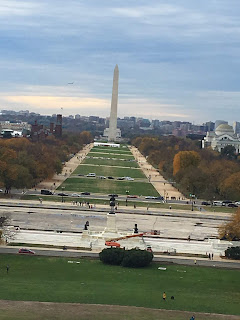One last visit to the front of the White House. This area is the closest you can get to the White House from the outside. This is also the area where protestors can assemble to voice their concerns.
Friday, November 9, 2018
Arlington Cemetery & Tomb of the Unknown Soldier
Arlington National Cemetery is a sobering tribute to the men and women who gave their lives to protect our freedom. The JFK gravesite displays Kennedy's inaugural address. Robert and Ted Kennedy are buried here as well. The Tomb of the Unknown Soldier changing of the guard ceremony is worth standing and waiting for -- happens every hour on the hour during daylight and every 6 hours at night. On our visit the Army band played several songs including the National Anthem and a soldier played taps. Its very moving and everyone is silent throughout the ceremony.
Bureau of Printing and Engraving aka "The Money Factory"
The
Bureau of Printing and Engraving also called the “money factory,” gives a tour
of the printing machines and process of how we print our money. You cannot take photos inside the factory,
only in the lobby/gift shop. 95% of
money printed is used to replace money that is deemed worn and as it is
returned by banks, the Federal Reserve issues new money. Engravers intern for
10 years to learn how to design the money.
International Spy Museum
As
you enter the spy museum you can select and identity and memorize facts about
the person so that throughout the time, you go through check points and see if
you pass. It’s a fun and interesting place.
There are real spy artifacts from U.S. and KGB spys. Guns are camouflaged in umbrellas,
flashlights, lipstick tubes and on and on.
It was so interesting I forgot to take any pictures so clipped all of
these from the Internet.
The
museum chronicles the history of spying from biblical times to the early 20th
century. It explores such phenomena as the institutionalization of spying in
the early years of the Soviet Union and traces the rise of
espionage technology, such as spy photography. It also examines the role that
women have played in espionage and reveals well-known historical figures who
were also spymasters, including George
Washington and author Daniel Defoe.
There are exhibits, films, and videos examine espionage
through World War II, showcasing real-life spy stories
such as Julius & Ethel Rosenberg. The lives of more recent double agents
such as Aldrich Ames and Robert Hanssen are covered. An exhibit on celebrity spies
details famous figures who had separate careers in espionage unbeknownst to the
public, including singer Josephine
Baker, chef Julia Child, baseball legend Moe Berg,
movie director John Ford, and actress Marlene
Dietrich.
 |
| you can see the flashlight and umbrella guns here |
Wednesday, November 7, 2018
U.S. Marine Corps Iwo Jima Memorial
After dinner we went to Arlington, VA to see this memorial. It was
inspired by the iconic 1945
photograph of six Marines raising a U.S. flag atop Mount
Suribachi during the Battle of Iwo Jima in World War II. The war memorial is dedicated to all U.S. Marine Corps personnel who died in the defense of the United States since 1775.
United States Capitol
Our Congressional office for our district in Oregon, Greg Walden, set up the tour and a congressional intern took us through. Underground tunnels connect the Capitol office buildings, Rayburn and Longworth. The Capitol also has it’s own separate water and air systems. We saw a lot more than the tours you take via a tour bus company. We walked the underground tunnel that is also serviced by a monorail type train for staffers only. We were able to see the old Supreme Court that was used from 1810-1860 and is still preserved as it was. From there we went to the Senate Speaker’s balcony for a great view.
 |
| Old Supreme Court |
 |
| waiting in Greg Walden's office for the tour |
 |
| Staff tram in subway |
 |
| Balcony just outside Senator Mitch McConnell's office. |
 |
| Box Magna Carta was delivered in -- diamonds in back |
 |
| Rosa Parks |
 |
| Office of Speaker of the House, Paul Ryan |
 |
| Top of the Rotunda |
Subscribe to:
Comments (Atom)






























